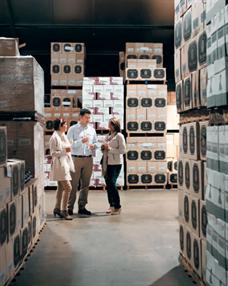Located just North-West of Stellenbosch, and cooled by salty sea breezes, the Bottelary Hills Wine Route offers award-winning wines as well as old-fashioned farm hospitality.
For some reason I’d always associated the name ‘Bottelary’ with bottles or even a bottling plant – not a very romantic association (no matter how appropriate) for this charming sub-route of the Stellenbosch American Express Wine Routes. So I’m delighted to discover that it is actually derived from the old Dutch word ‘bottelarj’ or English ‘buttery’, in Medieval times a service room in which ‘butts’ (casks) and bottles of liquor were stored; later a larder or pantry for food as well as wine. It’s the perfect association for a group of Bottelary Hills winemakers as they gather at Villiera for an end-of-harvest celebration lunch prepared by Christophe Dehosse, the acclaimed chef from nearby Joostenberg. As far as possible, Christophe sticks to produce from this ‘buttery’ of the winelands, including pork from Joostenberg itself, free of antibiotics and hormones, and vegetables from a farm tucked right between Joostenberg and Villiera.
On this occasion, a green lentil and seafood terrine is paired with two Cap Classique bubblies, namely Villiera Monro Brut 2007 and Mooiplaas Duel, followed by a salad of roast cherry tomato, rocket and marinated goat’s cheese served with either Goede Hoop Sauvignon Blanc 2012 or Mooiplaas Sauvignon Blanc 2009. Next on the menu is braised pork shank with tomato and lentil ratatouille Niçoise and creamy polenta, accompanied by Merlot courtesy of Hartenberg and Kaapzicht, and then comes panna cotta served with roast pineapple and citrus salad, perfectly complemented by Hartenberg’s Riesling Noble Late Harvest 2010 or, something very unusual for South Africa, an ice wine from Kaapzicht.
“Food must taste yummy,” insists Christophe. “Obviously it should be presented in a tempting way, but what’s the point of a plate that looks pretty if the food is cold? It’s like wine, which can have a fancy label or a simple label; what’s important is what’s inside.” With his back-to-basics approach, the French chef is perfectly at home in the Bottelary Hills, where Joostenberg’s neighbours include Bellevue, Beyerskloof, Goede Hoop, Groenland, Hartenberg, Hazendal, Kaapzicht, Klawervlei, Koelenhof, Koopmanskloof, Louiesenhof, M’hudi, Mooiplaas, Monterosso, Mostertsdrift, Stellenrust, Sterhuis and Vrede – many of which have been in the same family for generations. “There are very few commercially owned properties here,” says Danie Steytler, fourthgeneration winemaker at Kaapzicht Wine Estate. “We all earn our living from farming, not from other businesses with a bit of farming on the side.”
“We don’t have the fountains and flags that you see everywhere else in Stellenbosch,” adds Albert Ahrens, who joined Goede Hoop Estate as a consultant in 2009, having previously made wine at Lammershoek in the rustic but exciting Swartland wine district. “Bottelary is actually the most Swartland-like part of Stellenbosch, just without the heat or the Malmesbury brrrei,” reckons Albert.
“Here every farmer is a farmer. I love the simplicity.” For Tillie Viljoen, who joined Mooiplaas Estate as assistant winemaker in 2011, what makes Bottelary special is the sense of community. “If you need help, your neighbours are just a phone call away. Although the wine industry is very competitive, everyone here seems genuinely happy to assist. I don’t think there are many places like that anymore.”
You might expect long-standing members of the prestigious Cape Winemakers Guild to seem intimidating to young newcomers, but Villiera’s Jeff Grier and Hartenberg cellarmaster Carl Schultz are “very approachable”, according to Tammy Jeftha, who recently completed the Guild’s Protégé Programme. “The protégés spend three years being mentored by guild members, and so far they’ve all come out highly skilled and motivated,” explains Carl, so impressed with Tammy that he has appointed her on a permanent basis at Hartenberg. “She manages a team of eight men,” he reveals. “That takes a bit of chutzpah!”
The mutual respect and friendship between the winemakers is obvious at this lunch to celebrate the end of the 2013 harvest. “It’s been a very good red vintage,” comments Carl. “The berries were small, giving us good colour, and the unusually cool nights allowed us to pick our whites riper than usual, giving us intense flavours as well as naturally high acidities.”
Generally speaking, the slopes of the Bottelary Hills are kept relatively cool by ocean breezes off both False Bay and Table Bay, while the extremely varied soils are less fertile than in other parts of Stellenbosch. This partly explains why grape yields are about 4,8 tonnes per hectare, compared to an average of 6,6 tonnes per hectare for Stellenbosch as a whole. “The other reason for our low yields is that we have literally hundreds of hectares of bush vines,” says Carl.
Growing grapes unsupported by trellises, and typically without modern drip irrigation, is another similarity shared with the Swartland – tending to result in more intense flavours. “Our vines are naturally low yielding,” says Albert. “Sometimes I wish they’d yield a bit more!”
With the Bottelary Hills Renosterveld Conservancy at its core, the wine route is regarded as one of the ‘cleanest’ too. Sustainable farming is a major focus, with Villiera offering game drives as an innovative way to tell visitors about its environmentally friendly vineyard practices, and the indigenous trees that have been planted to offset carbon emissions. “After two hours they know our story, so when they taste our wine they like it even more,” laughs Jeff.
You can hear the Bottelary winemakers’ stories and enjoy their wines over one of the four-course Sunday lunches they host regularly for up to 50 people, costing R250 per person. The next one is at Kaapzicht on 25 August. To book, call 021-886-8275 or email [email protected].
By JOANNE GIBSON
SOURCES
Photographs by BRUCE TUCK

